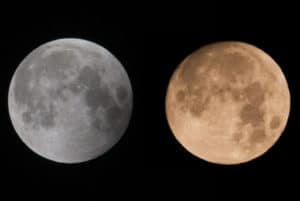 A lunar eclipse happens when the Earth comes between the Moon and the Sun, blocking sunrays, and the moon comes to pass the Earth’s shadow. This phenomenon happens in the middle of the month on the lunar calendar when the moon is at its fullest. The year 2011 witnessed four solar eclipses and one lunar eclipses, today being the second.
A lunar eclipse happens when the Earth comes between the Moon and the Sun, blocking sunrays, and the moon comes to pass the Earth’s shadow. This phenomenon happens in the middle of the month on the lunar calendar when the moon is at its fullest. The year 2011 witnessed four solar eclipses and one lunar eclipses, today being the second.
Kuwait meteorologists Al-Saadoun told KUNA, the eclipse would start with moon rise at 4:45 p.m. and last till 8:00 p.m. It is not a central eclipse and we would see some sunlight on the bottom side, and this would be the last eclipse this year. (Source: KUNA)
Here are few quick tips on Lunar Eclipse Photography, these setting are for DSLR cameras, but it should work on advanced point and shoot compact cameras too. Please check on your camera user manual guide.
• Use telephoto lens (focal length above 200mm recommended). If you don’t have one try to use wide angle lens with some interesting foreground or landscape feature, in this case the moon will appear small.
• Use the camera’s built in light meter to determine the exposure for you since the brightness of the moon shall vary during the total eclipse.
• Use Manual mode, set the aperture and shutter speed for the correct exposure of the moon.
• Use spot/point metering mode.
• Use Tripod. If you don’t have a tripod, use stable place to set your camera or least use sturdy support to balance your hand.
• If you set the camera to aperture mode instead of manual mode, choose the maximum aperture for your lens to give the fastest shutter speed at ISO 100.
• Low ISO (check your camera setting for low ISO) preferred if you are using Tripod. You can also use higher ISO depending on your camera setting to reduce blur caused by long exposure. Higher ISO shall increase noise in your photograph, which can be reduced to certain degree while PP (post processing).
• To prevent camera shake, use a cable release. If you don’t have one, you can still use the self-timer so that the shutter will activate in a few seconds after you press the button.
• Turn on Image stabilization (some camera lens denotes as IS, VR and OS) if you are shooting hand-held. If on tripod, it’s best to off Image stabilization to reduce motion blur.
• Noise Reduction ON/OFF depending on your choice. Turning On Noise Reduction increases the time for camera to process and save images to memory card. Noise Reduction feature can be done while PP.
• Fill the moon in your frame to see the beautiful 3D spherical appearance of the moon.
• Some photographers shoot the moon going through the entire eclipse using time lapse photography. Though I haven’t used this feature, the images can be combined in Photoshop as well as made into a video. You can see time lapse photo done by my blogger friend Mathai here.



Nikon d60, Total Lunar Eclipse, June 15-16 2011, Sharjah, UAE
Thanks Anil for sharing the image, sorry for a late reply.